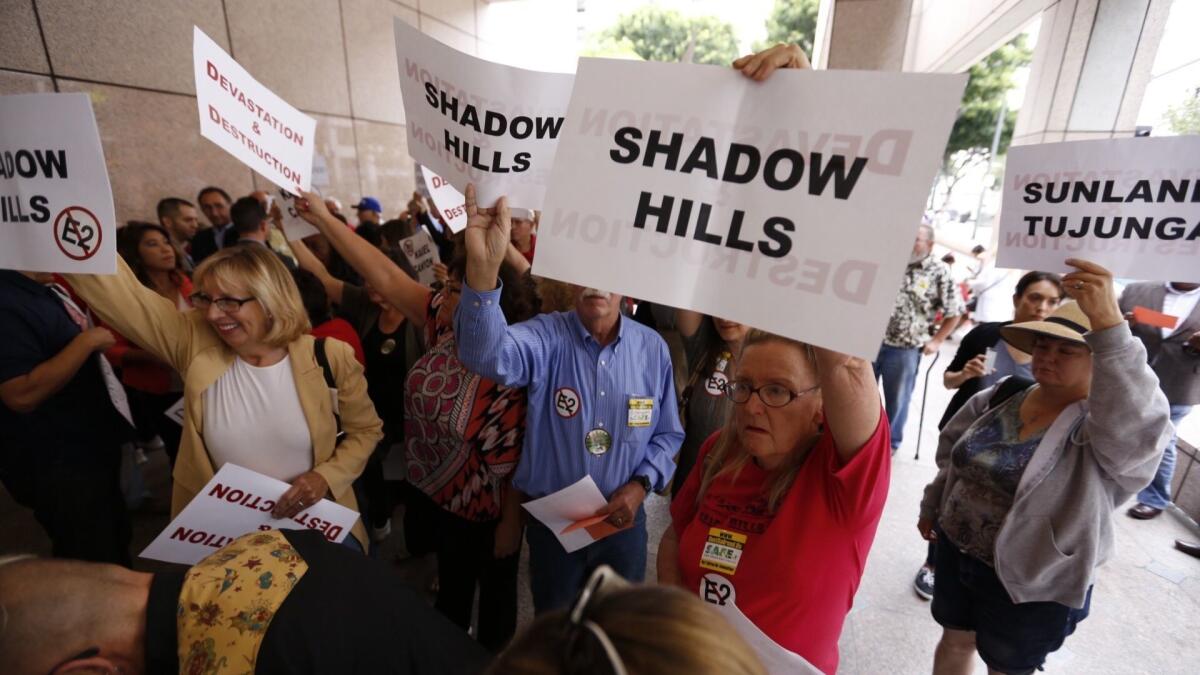California bullet train picks its path between Burbank and Palmdale

- Share via
The California bullet train would cut through Sun Valley, San Fernando, Santa Clarita and Agua Dulce, the state rail authority proposed Wednesday as it laid out its plans for the complicated route from Burbank to Palmdale — one of its most controversial and costly segments.
Compared with other alternatives, the route would be the easiest to build and cause the least harm, rail authority officials said, but it is likely to face intense opposition from communities and institutions along the way.
The 38-mile route closely follows the 14 Freeway through the San Gabriel Mountains via five separate tunnels, numerous bridges and various sections that would run at-grade.
If the plan is selected by the California High-Speed Rail Authority board, its myriad impacts on the community and environment would be detailed by next year in extensive environmental documents. But it appears that the route could affect homes, businesses, horse ranches, schools, the Angeles National Forest, an airport and a hospital.
The decision was based on an attempt to balance the objectives of building the railroad with its effects on the environment and communities along the route, said Michelle Boehm, the rail authority’s Southern California regional director.
“No route is perfect,” she said in a web address that did not take news media questions.
The route beat out two other potential paths that would have cut deeper into the national forest and potentially had great effects on water resources as a result of deep tunnels in ancient aquifers. The route following the 14 is the easiest and fastest to build, Boehm added, noting that the geology along the route was better for tunneling.
The selection was not based on cost, though risk and ease of construction was a factor.
One of the biggest challenges of the entire bullet train project is the passage it will have to make over the San Gabriel and Tehachapi mountains, which could cost between $26 billion and $45 billion, according to the rail authority’s 2018 business plan. The preferred route through the San Gabriels includes a 13-mile and a 7-mile tunnel — part of the most ambitious tunneling project in U.S. history.
Because the rail authority lacks funding for the job, it has delayed that part of the project, meaning the state’s largest city will be the last to be connected in the Los Angeles-to-San Francisco system.
The route will probably face stiff opposition in a number of communities along the way, which have demanded over the last two years that the entire passage from Burbank to Palmdale be underground.
Santa Clarita Councilwoman and Mayor Pro Tem Marsha McLean said she was disappointed that the route maps released Wednesday do not provide adequate detail to understand their exact effects on neighborhoods. The route would emerge from its southernmost tunnel at Branford Street near San Fernando Road in Pacoima, a business area north of a high school and a hospital.
The Santa Clarita City Council had told the rail authority it would oppose any route that was not fully underground, McLean said.
“Anything above ground takes out homes, schools and churches,” she said. “That is not going to happen.”
Los Angeles Mayor Eric Garcetti has strongly supported the rail project and over the last few years kept his distance from opposition groups in city neighborhoods along the route, including Shadow Hills, Lake View Terrace, Pacoima, Sylmar and Sun Valley. A spokesman for Garcetti said he was observing the Yom Kippur holiday and was not available to discuss the decision.
Garcetti had advocated in letters to the rail authority that it use the existing Metrolink commuter rail right of way from Burbank to Palmdale, a twisty route that was built in the 1870s by Southern Pacific. Such a compromise, which was supported by other Southern California officials, would have been similar to the deal made in the Bay Area to use the Caltrain right of way from San Jose to San Francisco.
But the state nixed the proposal.
David DePinto, who heads the watchdog group Save Angeles National Forest for Everyone, criticized state officials for calling the route the best alternative.
“It is the choice of lesser evils,” he said, noting that it would have a potentially devastating effect on Sun Valley and other communities. The group has long had concerns about disruption from construction, the seizure of private homes, the impacts on the area’s unique equestrian culture and the noise of high-speed trains, he said.
DePinto said the rail authority failed to abide by a commitment it made publicly this year to hold a board meeting in the San Fernando Valley before the selection of a preferred alignment. The board plans to hold a meeting in the area in November.
The rail authority plans to make public its draft environmental documents under federal and state laws in 2019, allowing the public, businesses and other government agencies to file formal comments. A final report would be issued in 2020, which would be made into a formal decision. The rail authority will begin a community outreach program in coming weeks, which should provide additional details.
The rail authority’s business plan says the Los Angeles-to-San Francisco system would be completed by 2033. But because there is not funding to build the Southern California segment of the system, it is impossible to know when any construction here would actually begin. The projected costs hit $77 billion this year, more than double the original estimate, and its completion date is now more than a decade delayed.
Follow me on Twitter @rvartabedian
More to Read
Sign up for Essential California
The most important California stories and recommendations in your inbox every morning.
You may occasionally receive promotional content from the Los Angeles Times.














